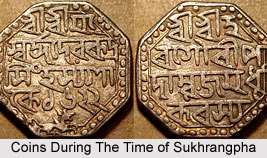 Sukhrangpha ruled over Ahom kingdom from 1332 CE to 1364 CE. He was the eldest among the four sons of Sukhaangphaa, another Ahom king. Sukhrangpha succeeded the throne, after the death of his father, as the king.
Sukhrangpha ruled over Ahom kingdom from 1332 CE to 1364 CE. He was the eldest among the four sons of Sukhaangphaa, another Ahom king. Sukhrangpha succeeded the throne, after the death of his father, as the king.
At the beginning of his reign Sukhrangpha encountered a great revolt by Chao Pulai, his younger brother. Chao Pulai weaved a conspiracy to overthrow the rule of Sukhrangpha. His conspiracy was however detected and he fled to Kamata kingdom, since Chao Pulai was the son of a Kamata princess. His uncle, the ruler of Kamata kingdom, and helped him by sending army against Sukhrangpha. Chai Pulai also gathered several supporters from the Ahom kingdom. Sukhrangpha was aware that his regime was not much popular and could not rely on the loyalty of certain sections of people of his kingdom. On knowing about the developments on Chai Pulai`s end, Sukhrangpha in order to avoid a conflict reached at an agreement with Chai Pulai. He resolved the matter by appointing him as the Charing Raja of the kingdom. It was a newly created post for an administration of a region called Charing, which was the tract on the right bank of the Burhidihing River, Joypur.
Later the post was used for the heir apparent of the Ahom kingdom. Through this post the successors of Ahom kingdom gained valuable experience of the administrations prior to achieving the throne. Some historical records state that Chaopang Banduk Borgohain initiated the conspiracy of Chai Pulai whereas others state that he manipulated the king against Chao Pulai. But finally, owing to any of the reason, Chaopang Banduk Borgohain was dismissed from the office of the king. Fate of Chaopang Banduk Borgohain has also contradictory explanations, as according to some accounts he was executed on the orders of Sukhrangpha while some say that he escaped from the kingdom and was later forgiven after the matter had blown over.
Apart from the revolt of Chai Pulai, Sukhrangpha marked a peaceful reign devoid of any major events. Gunaviram Barua who was a prominent Assamese historian stated that Sukhranphaa captured the neighbouring bank of Brahmaputra River for the expansion of his kingdom. He battled with the tribal chieftains and defeated them. Sukhrangpha ruled over Ahom kingdom for about thirty two years and died in 1364 CE. Events following his death have again contradictory explanations. Some say that after his death Sutuphaa, his brother, succeeded his throne. Other historians believe that after his death there was a period of interregnum between the period of 1364 CE and 1369 CE. After this period the nobles had installed Sutuphaa in the throne.



















